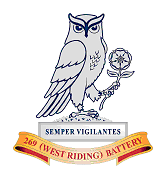| 269 (West Riding) Battery RA | |
|---|---|
 Badge of 269 (West Riding) Battery | |
| Active | 1 April 1975- |
| Country | United Kingdom |
| Branch | |
| Type | Army Reserve |
| Role | Precision fire |
| Size | 1 Battery (Company strength) |
| Part of | 101st (Northumbrian) Regiment Royal Artillery |
| Garrison/HQ | Carlton Barracks, Leeds |
| Nickname(s) | The West Riding Gunners |
| Motto(s) | Semper vigilantes (Always vigilant) (Latin) |
| Colors | Yellow, white, and blue |
| March | British Grenadiers |
| Anniversaries | Yorkshire Day (1 August) St Barbara's Day (4 December) |
| Equipment | Guided Multiple Launch Rocket System |
| Engagements | Bosnia, Kosovo, Cyprus, Iraq, Afghanistan Operation TELIC, Operation HERRICK |
| Commanders | |
| Battery Commander | Maj William Jagger RA |
| Insignia | |
| Tactical Recognition Flash |  |
269 (West Riding) Battery Royal Artillery is part of 101st (Northumbrian) Regiment Royal Artillery, an artillery regiment of the British Army. The unit is based in Carlton Barracks, Leeds. [1]